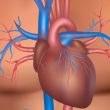The presence of lesions in multiple vessels is common in ST-segment elevation myocardial infarction (STEMI). It has been shown that, when they are treated in a second procedure, patients have a better outcome. To date, there is limited information available on percutaneous transluminal coronary angioplasty (PTCA) in vessels with severe non-culprit lesions during primary angioplasty....
Predictors and Evolution of Need for PPM after TAVR with Self-Expanding Valves
In the context of TAVR, one of the current challenges is the need for permanent pacemaker implantation (PPM), especially when using self-expanding valves (SEV). The information available in this regard remains controversial; while some studies suggest new PPM implantation will have no significant effect on clinical evolution, others have associated them with worse prognosis. As...
ESC 2023 | OCTOBER TRIAL: Should We Begin to Consider OCT for Bifurcation Lesions?
The OCTOBER Study randomized 1201 patients with bifurcation lesions in a 1:1 ratio to undergo percutaneous transluminal coronary angioplasty (PTCA) guided by optical coherence tomography (OCT) or by angiography. The primary endpoint (PEP) was major adverse cardiovascular events (MACE) over a 2-year period. Group characteristics were similar. The average patient age was 66 years, most...
ESC 2023 | ILUMIEN IV: What Is the Benefit of OCT?
Researchers conducted a randomized study that included a total of 1233 patients who underwent percutaneous transluminal coronary angioplasty (PTCA) guided by optical coherence tomography (OCT) and 1254 patients who underwent the same procedure but were guided by angiography. The latter had complex lesions. The initial groups were similar. The average age was 65 years, most...
EASTBOURNE Registry: Use of Sirolimus-Coated Balloons in Coronary Artery Disease
The introduction of drug coated balloons (DCB) has become an innovative therapeutic alternative to current treatments. Paclitaxel-coated balloons (PCB) have been used to treat in-stent restenosis (ISR) and also approach CAD in native arteries. More recently, sirolimus-coated balloons (SCB) are being looked at as part of pilot studies and smaller registries with preliminary results. The...
Predictors and Evolution of Permanent Pacemaker After TAVR with Self-Expanding Valves
Transcatheter aortic valve replacement (TAVR) has shown remarkable benefits and continues to advance towards lower-risk patients and younger ages. However, one of its limitations lies in the demand for a permanent pacemaker (PPM), which during TAVR early stages with self-expanding valves reached 30%. Uncertainty persists regarding the evolution of patients undergoing PPM implantation after TAVR,...
Moderate Aortic Stenosis: We Should Start Assessing It More Thoroughly
Moderate aortic stenosis (MAS) encompasses a broader spectrum than severe aortic stenosis. However, its progression has not yet been fully elucidated. While there are reports suggesting that this condition is not as benign as initially believed, there is a need to consider early interventions in certain instances. Researchers conducted an analysis from January 2016 to...
Crisis and Socioeconomic Disparities: Relationship with Recurrent Events After Myocardial Infarction
Socioeconomic status (SES) has been linked to recurrent atherosclerotic cardiovascular disease events (rASCVD) after myocardial infarction (MI). However, patients with low SES are underrepresented in most randomized studies. This may be largely due to a higher incidence of metabolic syndrome, insufficient use of recommended medication, such as statins, for secondary prevention and insufficient participation in...
Secondary Prevention with P2Y12 Inhibitors: How Consolidated Is This Long Term Alternative vs. Aspirin?
Secondary prevention with P2Y12 inhibitors vs aspirin monotherapy in CAD patients Antiaggregation therapy plays a central role at long term to prevent new cardiovascular events in atherosclerosis patients. After repeat myocardial infarction (MI) or stroke, prognosis can vary considerably. Even though the current guidelines prefer aspirin as the first choice for secondary prevention over P2Y12...
What Is the Prognosis of an Acute Myocardial Infarction in the Presence of Moderate Aortic Stenosis?
Aortic stenosis (AS) is a common condition that shares risk factors with coronary artery disease. Many patients can suffer from both diseases simultaneously, something that increases the risk of acute myocardial infarction in the presence of aortic stenosis. AS can cause ischemia even in the absence of coronary artery disease, due to ventricular hypertrophy, increased...







